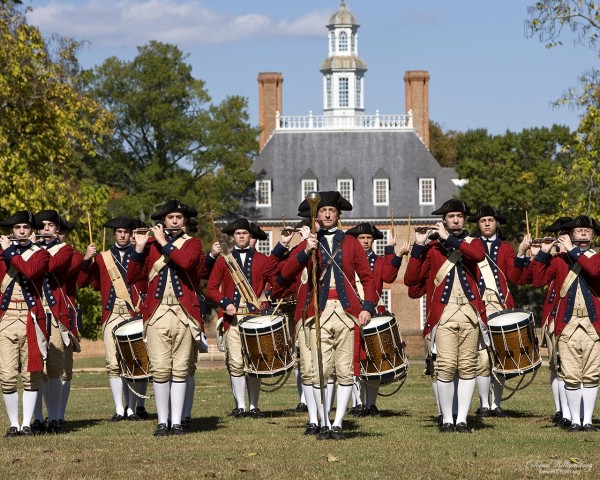
It’s one of those glorious autumn mornings in Colonial Williamsburg’s Historic Area, a whispering breeze rustling leaves that are flirting with a deeper shade. No better day to begin the journey of a lifetime.
The recruits have anticipated this moment for a while and for their parents, it probably seems even longer. In fact, it’s the parents who made the effort years before to put their child’s name on a waiting list, just for this. How distant this day seemed then.
And now the day is here. Now it’s their turn to join the Colonial Williamsburg Fifes and Drums.
Today the recruits’ enthusiasm is tempered only by the realization of just how long a road lays ahead of them.
On this day, the Fifes and Drums building hustles with energy. It’s the epicenter of every note and tap, every tune and rudiment, every performance of the Fifes and Drums. The walls inside this modern brick structure are decorated with photos, awards and musical instruments that chronicle the Fifes and Drums’ 57-year history and each new class.
This morning, the newbies gather in the “Big Room,” a wide open practice hall about the size of a tennis court. The recruits‒11- and 12-year olds accompanied by their parents‒find seats and await instruction, and are quickly lost in the excitement.
Older fifers and drummers flit about, dressed in a melange of 18th-century period attire and their 21st-century clothes, tapping out rhythms on drum pads, finding familiar fingerings on fifes, chatting and laughing and rolling their eyes as teenagers do. This could be any Saturday morning practice, except for the presence of the recruits, patient and slight, seated beside their parents in folding chairs. You can see the awe and admiration of the older musicians in their eyes‒and it makes them seem even smaller.
“Fall in!” shouts a voice from a far corner. At once the buzz stops and the milling musicians form a phalanx in the middle of the room. At the command of “Fifes and Drums. … Attention!” the fifers and drummers snap straight, their heels clicking in unison. Their discipline and uniformity seem almost effortless.
This is the first of perhaps hundreds, if not thousands of times the recruits will hear those words.
In many ways this year’s incoming class mirrors the Fifes and Drums at large. There are seven boys and nine girls. They’re at that awkward age when the girls are a bit taller than the boys. The corps has been co-ed since 1999, several years before these recruits were born.
Five girls play fife; four play drums. The split is not so even among the boys‒five of the seven are on drums.
For a handful, their musical fate in this corps was sealed. Three have an older sibling in the Fifes and Drums; one’s father was a member. History and civics seem to pulse through their veins. A couple are the children of current or former Colonial Williamsburg employees. Family members are veterans, hold elective office, teach social studies. The recruits are already individuals. One likes to knit. Another claims an uncanny ability to communicate with animals.
Differences aside, there’s a sense of unity, a larger purpose that brings them together today; the Fifes and Drums of Colonial Williamsburg demands individual progress, but in the end is a corps‒a group‒and these recruits have chosen to surrender a slice of self-identity to make a whole that’s greater than the sum of its parts.
They will learn together, perform together, travel together. And if history is any indication, they may grow old together, too. Members of the Fifes and Drums often remain lifelong friends, thanks to camaraderie cultivated over eight years of companionship.
But all that is a ways off. First come baby steps, which must be altogether, of course.
After the rank-and-file musicians are dismissed to find practice space, Fifes and Drums leaders share nuts-and-bolts information with the new families: the weekly schedule, where to pick up and drop off, major events for the coming year. With those formalities out of the way, the recruits, pre-teens through and through, are eager to bid adieu to their parents.
The first assignment involves mastering that basic command: “Attention!”
The lesson is led by two Fifes and Drums alumni, David Baker and Landon Stulen, Colonial Williamsburg employees given the formidable task of molding green recruits into something approaching order.
The instructors herd the tender throng to an area with enough space to move about, a parking lot for occupants of a few necessary buildings Colonial Williamsburg guests might never have occasion to visit. Aside from the Fifes and Drums building, there is the headquarters of security and the stables for Coach and Livestock. The recruits must move aside when horse-drawn carriages that have been gliding through the Historic Area retire for the crew’s lunch break.
The group seems underwhelmed with the inglorious practice space, but takes it in stride nonetheless. The instructors form the recruits and offer a bit of instruction. “Fifes and Drums… Attention!” commands Baker, who will be Mr. Baker to the recruits. In fact, everyone -instructors, recruits, fifers and drummers-are addressed only by surnames.
The recruits’ response is less than swift and not at all sharp. More clatter than a single crack. Moments ago, inside the Fifes and Drums building, the older musicians came to order, their heels all finding a single, staccato moment in unison. With time, these recruits may be there, too.
Several steal a sidewise glance to compare their wobbly stance to a neighbor’s. A few look off in the direction of the Capitol as the clock offers 11 long gongs.
The instructors seem largely unconcerned; they’ve seen this before. They were there themselves, in fact, years ago. There’s plenty of room to grow and, importantly, time to make that happen.
And there is something else, too‒a spark, an eagerness in these recruits’ eyes. There’s a hunger that’s breaking through the uncertainty of learning their very first command on their very first day. They stand at their imperfect attention longer than they have to, even when commanded to rest. They anticipate their instructors’ admonitions and make corrections before the words are spoken.
Perhaps it’s not surprising, then, that two months later, they’ve turned about face. “Attention!” is quick and together. They’re marching as a group, and in step, no less. On this December day, they’re executing a difficult maneuver, a wheel, which allows the group to turn a corner without breaking rank.
And something else has come a long way, too‒the other critical component in this whole endeavor: the music.
In cramped practice rooms that first day of their fifes and drums career, they made hardly a sound on their instruments, and those they did were tenuous. Now they are getting the hang of rudiments and scales. The fifers even manage to blow out a passable rendition of “Widow Dixon. “
These young recruits have come a long way to get to this spot. They’ve shown their earnest desire to be here. And they’ve made remarkable progress.
For all those worthy accomplishments, though, their greatest challenges remain a long march away.
Through the Ranks is a periodic series that will follow the progress of the newest class of Colonial Williamsburg fifers and drummers. We’ll tell the story of their journey with photos, videos, audio podcasts and blog posts. Please join us.
 Ben Swenson lives in Williamsburg, Virginia with his wife and two sons. His writing career has led him to all sorts of odd corners of the world: he has jumped out of a perfectly good airplane, wrestled crab pots on a Chesapeake Bay work boat and taken a helicopter ride through a twisting river gorge. Odds are good you will find him outside with them somewhere when he is not chasing or telling stories.
Ben Swenson lives in Williamsburg, Virginia with his wife and two sons. His writing career has led him to all sorts of odd corners of the world: he has jumped out of a perfectly good airplane, wrestled crab pots on a Chesapeake Bay work boat and taken a helicopter ride through a twisting river gorge. Odds are good you will find him outside with them somewhere when he is not chasing or telling stories.
Leave a Reply